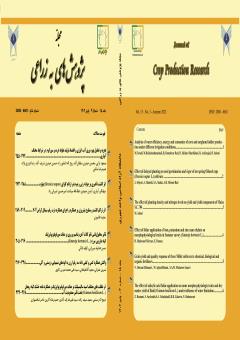The effect of salicylic acid foliar application on some morpho-physiologic traits and dry matter yield of Basil (Ocimum basilicum L.) under influence of water limitation
Subject Areas : Crop Production Research
Zabiholah Rostami
1
,
Saeed Sayfzadeh
2
![]() ,
SeyedAlireza Valadabadi
3
,
HamidReza Zakerin
4
,
ناصر شهسواری
5
,
SeyedAlireza Valadabadi
3
,
HamidReza Zakerin
4
,
ناصر شهسواری
5
1 - Department of Agronomy, Takestan Branch, Islamic Azad University, Takestan, Iran.
2 - Department of Agronomy, College of Agriculture, Takestan Branch, Islamic Azad University, Takestan, Iran
3 - Department of Agronomy, Takestan Branch, Islamic Azad University, Takestan, Iran.
4 - Department of Agronomy, Takestan Branch, Islamic Azad University, Takestan, Iran.
5 - گروه تولیدات گیاهی، دانشگاه آزاد اسلامی واحد حاجی اباد
Keywords: Basil, Carotenoid, Chlorophyll, Drought stress, Dry weight, Morphological characteristics, Salicylic acid,
Abstract :
In order to investigate the effect of foliar spraying of salicylic acid on some traits and dry matter performance of basil plants under the influence of water limitation, an experiment was conducted in the form of split plots based on randomized complete block design in 3 replications in a private farm located in Mahdasht area of Karaj city in 2015-2016 and 2016-2017 crop years. Irrigation in 4 levels: I1: 100%, I2: 80%, I3: 60% and: I4: 40%. The volume of water required in the main plots and salicylic acid in 5 levels: S1: No application (spraying solution with water net as control), S2: foliar spraying with a concentration of 50 μM, S3: 100 μM, S4: μM and S5: 200 μM were placed in the subplots. The results showed that the simple effects of drought stress and salicylic acid on the traits of stem diameter, inflorescence length, total chlorophyll, carotenoid and plant dry weight at 50% of flowering are significant at 1% level and the interaction effect of these two factors is also significant except for stem diameter. It was significant at 1% level on all studied traits. In general, salicylic acid increased stem diameter, inflorescence length, total chlorophyll and carotenoid, and with more water limitation, salicylic acid showed more positive effects in increasing the mentioned traits. With the increase in concentration of salicylic acid in all drought stress treatments, the dry weight of the bush showed a significant increase. The maximum dry weight of the bush was 3144.88, 3105.45 and 3045.67 kg per hectare related to the concentration of 200, 150 and 100 μM salicylic acid under the conditions of 100% water requirement. The highest dry weight of the bush in severe drought stress (40% water requirement), severe stress (60% water requirement) and mild drought stress (80% water requirement) belongs to the dose of 200 µmol/l salicylic acid, respectively, at the rate of 1596.45, 2033/2033 and 2327/36 kg per hectare. Our study showed that foliar spraying with salicylic acid is more effective in increasing the dry weight of the plant under water-limited conditions. According to the obtained results, it is recommended to use salicylic acid for the production of basil plants in order to adjust the drought stress in climatically semi-arid areas such as Karaj.


